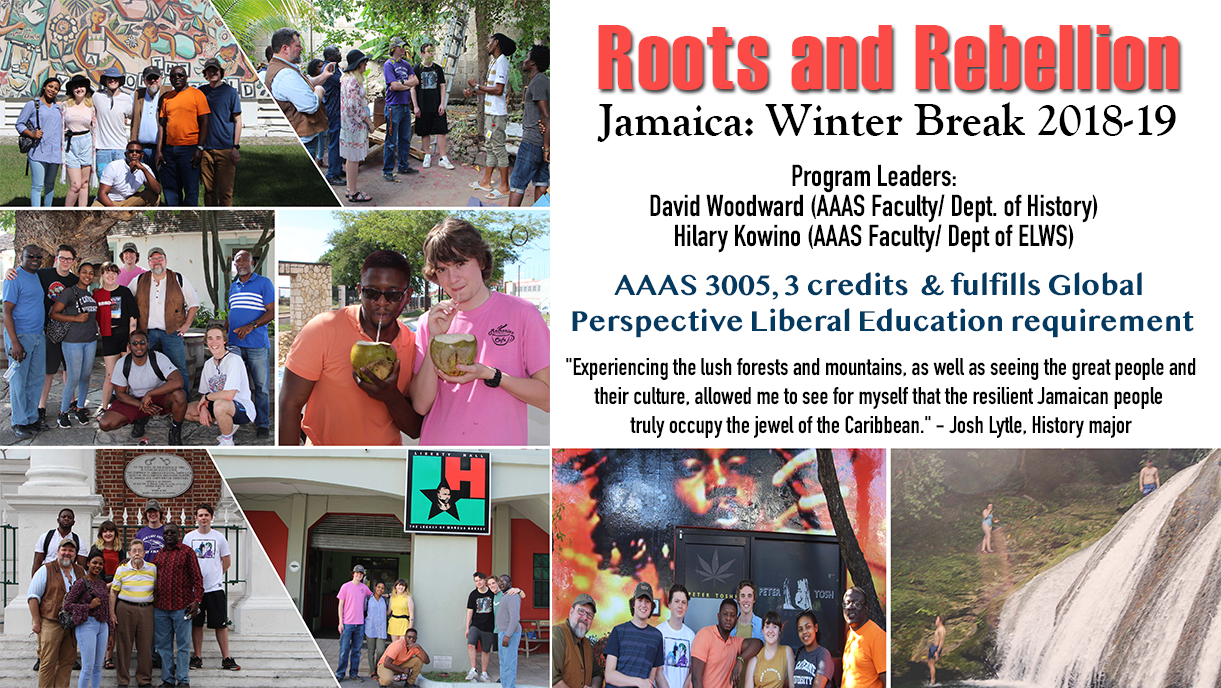
Roots and Rebellion - Study Abroad to Jamaica
Program Leader(s): David Woodward (AAAS Faculty/ Dept. of History) and Hilary Kowino (AAAS Faculty/ Dept of ELWS)
Cities: The University of the West Indies, Mona Campus, Kingston, Jamaica
Dates: December 30 - January 14
Course Attribute: AAAS 3005 (3 credits), meets elective requirements for the AAAS Minor. Fulfills Global Perspective Liberal Education requirement
About the Class: This Study Abroad Program to Jamaica course draws on history, literature, cultural studies, and music to develop a critical understanding of Jamaica's resistance to colonialism and slavery. Anchored on Bob Marley’s popular protest against imperialism -- “We refuse to be what you wanted us to be; We are what we are: That’s the way it’s going to be” – the course seeks to help students acquire a deeper appreciation of the Jamaican experiences of oppression, rebellion, and globalization. As it highlights Jamaicans’ struggle for cultural, political, and economic rights, the course enhances students’ grasp of diversity, global competence, and global perspectives.
Who, What, Where
The students explored Jamaican culture, literature, music, and history by reading required texts, watching assigned films, attending special topics presentations by UWI Mona professors (such as Professor Clinton A. Hutton), interacting with UWI Mona students, exchanging ideas with Jamaican citizens, visiting cultural heritage sites, learning from heritage professionals and community leaders, and listening to selected music.
For example, students visited the following heritage sites:
- Guided tour of UWI Mona – The campus is a triumphant story of rebellion and transition from a slave plantation to a university; moreover, a story of rebellion and transition from the University of London to the University of West Indies Mona. Our Study Abroad Program to Jamaica began here, and one of the UWI Mona graduate students led the tour and presentation.
- Guided tour of Bob Marley Museum – This provided an opportunity for our students to appreciate the legacy of Bob Marley as an ambassador of world peace, an inspiration to international movements of independence, and an icon of Rastafari socio-religious movement. One of the Bob Marley heritage professionals spoke to the culture, history, and principles of Rastafari.
- Guided Tour of Peter Tosh Museum -- This focused on Peter Tosh as a champion of justice and equal rights.
- Guided tour of Liberty Hall – The students visited the headquarters of United Negro Improvement Association (UNIA) as a tribute to Marcus Garvey’s life and achievements. The students learned about Marcus Garvey’s role as a Pan-Africanist who resisted colonialism and poverty.
- The Maroon Village of Accompong – This is a historical Maroon village in a mountainous area whose unique terrain strategically allowed Maroons and indigenous Taino to “establish a fortified stronghold in the 17th century. They defended it to maintain independence from the Spanish and then later against British forces, after the colony changed hands. The people named their community Accompong after an early Maroon leader. Their autonomy with certain rights for limited self-government was established by a peace treaty with the British in 1739. Since independence in 1962, the government of Jamaica has continued to recognize Maroon indigenous rights in this area.”
- Bull Bay – Geographically located on the southeast coast of Jamaica, Bull Bay accommodates various Rastafarian communities, including the Bobo Ashanti and Twelve Tribes of Israel. We visited the Twelve Tribes of Israel Mansion/ Community to learn about the genesis and meaning of Rastafari as well as the Twelve Tribes of Israel Mansion's progressive social and spiritual movement. We also attended a reggae concert to appreciate the relationship between music and resistance in the Rastafari world. While we did not visit Bobo Ashanti, we learned about their call for reparation, support of Marcus Garvey’s Back to Africa Movement, and commitment to a culture of transgression/ subversion as exemplified in their reversal of the Rastafarian flag from green-gold-red to red-gold-green.
- Tour of National Gallery of Jamaica – to appreciate artistic and cultural heritage of Jamaica from its indigenous roots through contemporary expression.
- Lifeyard -- a transformed space that showcases sustainable community development.
- Guided tour of Fort Charles + Port Royal Village + History of Port Royal + Museum – Originally named Fort Cromwell, this was the first fort built in Port Royal between 1650 and 1660. Spanish Town – served as both the Spanish and British capital of Jamaica from 1534 to 1872. It is now the capital of St. Catherine Parish. We will visit the town’s memorials and monuments
- Literary Village in Woodside District -- the role of literature and literacy in the sustainable development of a community. Assigned literature such as Michelle Cliff's Abeng in relation to the socio-cultural landscape of Jamaica
- Bus tour of Kingston -- the history of Kingston
- Winifred Beach -- for recreation
- Fort Clarence Beach -- for recreation.
Why participate in this program?
The African and African American Studies Program views this interdisciplinary course as a wonderful opportunity for our students to appreciate different ways of living in the world -- the course advances heterogeneity as a prerequisite for coexisting with billions of strangers in the era of globalization. Following a sustained encounter with counter-epistemologies/ marginalized narratives, our students return to UMD with a transformative understanding of Jamaica's legacy of resisting imperialism. Indeed, the course is a process of indicting cultural denigration, championing decolonization, and celebrating diversity.
Student Perspective
"It was one of the greatest, eye-opening experiences I've ever had." - Amane Ejero, Public Health major
"Experiencing the lush forests and mountains, as well as seeing the great people and their culture, allowed me to see for myself that the resilient Jamaican people truly occupy the jewel of the Caribbean." - Josh Lytle, History major